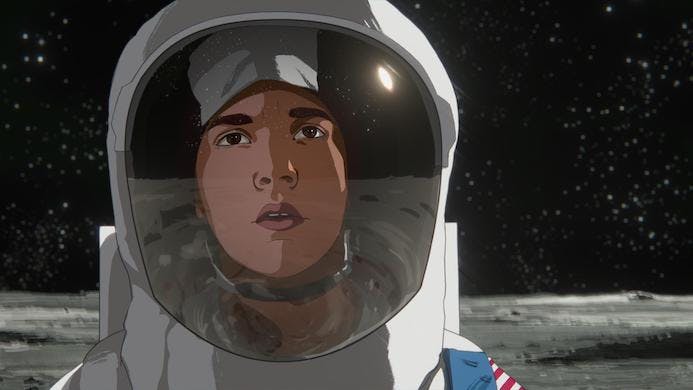Redrawing the Space Age With Fact and Fantasy
Writer-director Mr. Linklater again employs rotoscoping — drawing over live-action footage — to illustrate alternate realities, as with his ‘Waking Life’ (2001) and ‘A Scanner Darkly’ (2006).

Writer-director Richard Linklater draws on his memories of growing up in late-1960s Houston as the basis for “Apollo 10 1/2: A Space Age Childhood,” an animated feature that evokes authentic sights, sounds, and thrilling feelings of life during a time that was simpler yet full of adventure and promise.
Narrator Stan (voiced by Jack Black) tells us that as a fourth-grader he was scouted by NASA to become an astronaut after the agency erroneously built a lunar module that was way too small. Soon afterward, he betrays his unreliability as a narrator by allowing that he was a bit of fabulist as a youngster and invented tall tales for show-and-tell at school.
Turns out young Stan (voiced by Milo Coy) actually just wanted to impress classmates by capitalizing on having a NASA-employed father (Bill Wise), conveniently glossing over that pop was merely the shipping and receiving manager.
In the Houston suburb where everybody and everything was somehow connected to NASA, astronomy was taught in science classes and kids counted down every blast-off at school and at home. The historical milestones everyone witnessed were part of the communal experience. Indeed, the epilogue titles state that 600 million people have watched Neil Armstrong and Buzz Aldrin’s one small step.
The film implies that Stan, while waiting up past bedtime for the Apollo 11 launch, might have internalized the live broadcast as firsthand experience in a half-conscious delirium. While moviegoers and the narrator himself are cognizant of the impossibility of his taking a space voyage as a child, images of the astronauts’ movements certainly have been deeply ingrained in our collective consciousness for a few generations.
In addition to recalling the cultural impact of the space program, the film keeps in the fold of what was happening in society during that time. The country was in a state of upheaval amid war and assassinations, but those were far removed from Stan’s daily realities — save for the occasional bomb drills.
Much that is old now was new then: heart transplants, push-button telephones, a stadium paved with AstroTurf, the Clean Air Act, the Clean Water Act, etc. His father could freely sip a beer while behind the wheel. Adults pinched every penny because they or their parents had lived through the Depression and feared it might happen again. This all is really the crux of the film.
Much like Disney/Pixar’s “Turning Red,” the details and specificities in “Apollo 10 1/2” may resonate with some while alienating others. Those who lived through the era and recognize all its signifiers will get the most out of the film.
Mr. Linklater again employs rotoscoping — drawing over live-action footage — to illustrate alternate realities, as with his “Waking Life” (2001) and “A Scanner Darkly” (2006). With “Apollo 10 1/2,” this animation technique represents memories and the dream state. Animations of the simulation training, the spacecraft, and the launch itself seem hyper-realistic.
Thanks to rotoscoping, one can’t discern whether the film actually employs elaborate sets and props or simply incorporates archival footage — so the technique makes perfect sense. Impressively, the animators have managed to create muddled textures for scenes meant as archival footage or broadcast news, as opposed to the clarity of reminiscence.
Mr. Black’s narration is understated, unlike his screen persona. Perhaps, though, the more manic type of performance we often see from him would have been a bit more engaging: A 98-minute movie that is entirely narrated sometimes can feel one-note.
Still, “Apollo 10 1/2” encapsulates a way of life and a particular moment in time in a way unlike other films, perhaps because of animation’s ability to convey better than live action the intrinsic feeling of collective memory. The film offers a rare opportunity to briefly relive the period and to share it with others.

